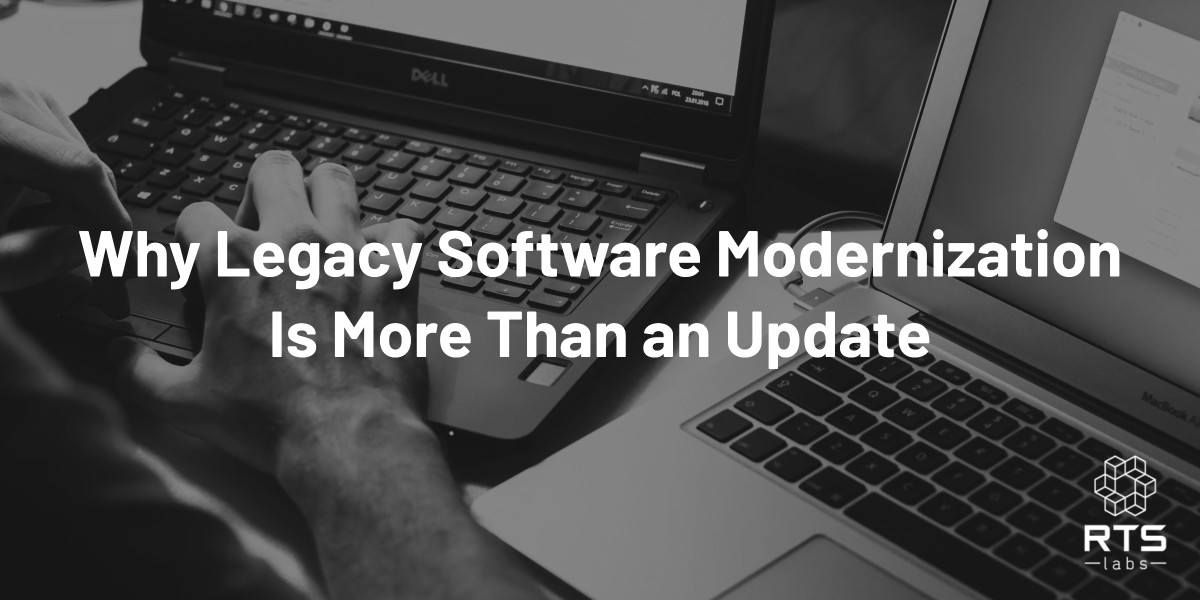“The biggest impediment to a company’s future success is its past success,” according to Dan Schulman, CEO of PayPal. In a business environment increasingly defined by big players with the ‘move fast and break things’ mindset, enterprises will need to continually reinvent and transform themselves to remain relevant. That’s the truth behind true digital transformation and why legacy software modernization is more than an update.
In our RTS Labs 101 guide to legacy systems modernization, we walk through why you may need software modernization and the basics of how to go about modernizing software and systems.
But an update on your legacy systems and software isn’t just about choosing a more efficient architecture or ripping and replacing software. In a business environment made up of both established enterprises and digital disruptors, modernizing is about transforming your organization to meet the demands of a rapidly expanding digital environment. And with modernization on the minds of most CIOs, it’s a pressing issue.
“In today’s world of exponential change, organizations that get too comfortable with the status quo are at major risk of disruption. If you’re not experimenting and, as a director, if you’re not asking questions about how your organization is navigating and plugging into disruption, forming new ecosystems, and tapping into open markets, then your organization is at risk.”
~ Andrew Vaz | Global Chief Innovation Officer | Deloitte
What can insights from some of the top consulting firms tell us about how legacy software modernization translates into true digital transformation?
Defining what makes up your legacy system
A legacy system is not typically a single component. It can refer to your full IT stack, your internal systems, your external communication channels and even your hardware. It can be the frontend and the backend. It can be your local server.
The best definition we’ve found so far of legacy systems and legacy modernization is the one we use in the 101 guide to legacy modernization. This definition touches on the importance of not upgrading simply for the sake of upgrading but upgrading outdated systems to make sure your enterprise stays relevant and agile:
“An information system that may be based on outdated technologies, but is critical to day-to-day operations. Replacing legacy applications and systems with systems based on new and different technologies is one of the information systems (IS) professional’s most significant challenges. As enterprises upgrade or change their technologies, they must ensure compatibility with old systems and data formats that are still in use.” [emphasis added]
~ Gartner’s IT Glossary
With this definition, the idea of what constitutes legacy applications and systems is relatively broad. Legacy systems could be the technology stack you’ve been relying on for a decade or the customer service solution you’ve been meaning to upgrade for the last two years. The commonality is that the legacy application or system is both critical to operations and outdated relative to the rest of your organization’s processes.
In other words, ‘old’ doesn’t necessarily mean ‘bad’ for legacy systems. It has much more to do with whether the system is viable for modern (and digital) operations. For example, if your enterprise is using local servers versus a cloud-based solution for a specific reason, you may want to look at modernization efforts that maintain the local server. But if you are on a local server just because cloud-based offerings were not viable for enterprises at the time, the cloud may have something new to offer.
The key to modernizing (not updating) legacy software and systems
Modernization does not necessarily require a complete transformation of your IT stack. However, it does require an honest assessment of where digital transformation is needed and a shift in your mindset. Gartner outlines seven different options for modernizing legacy systems and legacy software:
- Encapsulate: Use the features and value of existing applications, making them available as services.
- Rehost: Move components to a new physical or cloud infrastructure.
- Replatform: Leave applications nearly as they are, adapted to a new platform.
- Refactor: Optimize existing code on the backend without changing front end behavior or features.
- Rearchitect: Find new and better capabilities for applications with a complete shift in code.
- Rebuild: Build new applications from scratch but with a similar function and scope.
- Replace: Take new business requirements into account and build from the ground up.
While taken together, these seven options may look overwhelming, all these approaches to legacy modernization have at least one critical element in common: They require a close look at all your interconnected components, systems and applications. You cannot update one component without giving the others a serious look.
In some cases, this will require a ‘rip and replace’ response. But in others, you may be able to refactor some applications, rehost systems and rebuild with a digital environment in mind.
“In some ways, incumbents have a lot of benefits over new players, over start-ups. They have customers, they have great data, they often have a brand. They have financial resources, which a start-up may not have. The question is, can all of those capabilities and assets be deployed in a way that allows you to defend against new attackers as digital disrupts your industry?”
~ Paul Willmott | Director | McKinsey
In other words, the key to modernizing (rather than simply updating) legacy systems is to start with your business needs and capabilities and determine the right approach from there. Containerization in software and DevOps in building components out don’t exist in a vacuum. They are the natural result of shifting your mindset, as much as your IT stack, towards the digital (and therefore agile) environment.
What’s at stake for digital transformation
You don’t modernize your legacy systems just to become more efficient or up to date. You modernize to compete with digital disruptors. Organizations that are building their business from the ground up today have a leg up as they start from scratch with their technology stacks and architecture and with a sharp focus on the customer. You want to stay competitive; any legacy modernization efforts should help you achieve that primary goal.
“Beyond performance challenges, established companies are at a competitive inflection point. New digital disrupters can build new IT landscapes, while companies with legacy systems must seek ways to integrate new, digital technologies harvesting legacy technology to maximize their IT investments.”
~ Adam Burden | Global Lead for Advanced Technology & Architecture | Accenture
With that in mind, legacy software modernization is more than simply updating your software (and maybe some hardware to go with it). Staying competitive requires a dedication to change, experimentation and figuratively pushing the envelope. With an attitude attuned to digital transformation and the right strategy for legacy system modernization, you can give your enterprise a boost well into the future.
If you haven’t read it yet, check out “Your 101 Guide to Legacy Systems Modernization.” Then, call us to start the conversation if you have any questions about what upgrades – big or small – your system might need.






